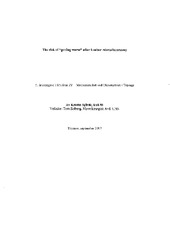Blar i forfatter "Sjåvik, Kristin"
-
Clinical Course in Chronic Subdural Hematoma Patients Aged 18–49 Compared to Patients 50 Years and Above: A Multicenter Study and Meta-Analysis
Bartek, Jiri; Sjåvik, Kristin; Dhawan, Sanjay; Sagberg, Lisa Millgård; Kristiansson, Helena; Ståhl, Fredrik; Förander, Petter; Chen, Clark C.; Jakola, Asgeir Store (Journal article; Tidsskriftartikkel; Peer reviewed, 2019-04-05)<p><i>Objective - </i>Chronic Subdural Hematoma (cSDH) is primarily a disease of elderly, and is rare in patients <50 years, and this may in part be related to the increased brain atrophy from 50 years of age. This fact may also influence clinical presentation and outcome. The aim of this study was to study the clinical course with emphasis on clinical presentation of cSDH patients in the young (<50 ... -
Perioperative quality assurance in neurosurgery
Sjåvik, Kristin (Doctoral thesis; Doktorgradsavhandling, 2018-06-08)Abstract Background Perioperative treatment for common neurosurgical conditions such as chronic subdural hematomas (CSDH) and meningiomas vary. The perioperative period is by definition the time span from 24 hours before surgery until 30 days postoperatively. Even if the surgical treatment in the operation theater can be exactly the same, complication rates differ, and results vary. The aim of ... -
The risk of "getting worse" after lumbar microdiscectomy
Sjåvik, Kristin (Master thesis; Mastergradsoppgave, 2003-09) -
Spatial distribution of malignant transformation in patients with low-grade glioma
Jakola, Asgeir S; Bouget, David Nicolas Jean-Marie; Reinertsen, Ingerid; Skjulsvik, Anne Jarstein; Sagberg, Lisa Millgård; Bø, Hans Kristian; Gulati, Sasha; Sjåvik, Kristin; Solheim, Ole (Journal article; Tidsskriftartikkel; Peer reviewed, 2020-01-09)<i>Background</i> - Malignant transformation represents the natural evolution of diffuse low-grade gliomas (LGG). This is a catastrophic event, causing neurocognitive symptoms, intensified treatment and premature death. However, little is known concerning the spatial distribution of malignant transformation in patients with LGG.<p><p> <i>Materials and methods</i> - Patients histopathological ... -
Triple use of autologous amnion graft in the treatment of meningomyelocele and split cord malformation
de Weerd, Louis; Sjåvik, Kristin; Pedersen, Lars Kjelsberg; Weum, Sven; Hennig, Rune (Journal article; Tidsskriftartikkel; Peer reviewed, 2020-01-20)This article describes the triple use of autologous amnion graft as a new procedure in the treatment of myelomeningocele and in myelomeningocele with split cord malformation. The first amnion graft was used as a physical and mechanical barrier to protect the myelomeningocele (MMC) from desiccation and mechanical stress directly after birth. A second graft was used as a dura substitute to close the ... -
Would loss to follow-up bias the outcome evaluation of patients operated for degenerative disorders of the lumbar spine?
Solberg, Tore; Sørlie, Andreas; Sjåvik, Kristin; Nygaard, Øystein Petter; Ingebrigtsen, Tor (Journal article; Tidsskriftartikkel; Peer reviewed, 2011)Loss to follow-up may bias the outcome assessments of clinical registries. In this study, we wanted to determine whether outcomes were different in responding and non-responding patients who were included in a clinical spine surgery registry, at two years of follow-up. In addition, we wanted to identify risk factors for failure to respond. 633 patients who were operated for degenerative disorders ...


 English
English norsk
norsk



